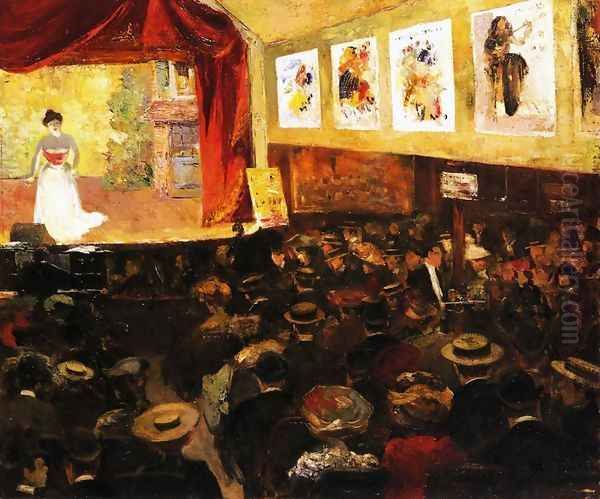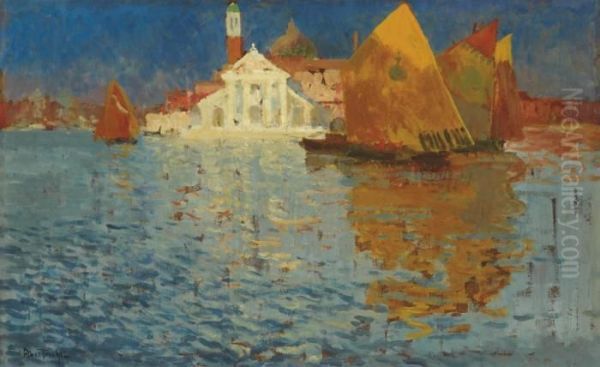
Louis Abel-Truchet stands as a significant figure in French art during the vibrant period spanning the late nineteenth and early twentieth centuries. A versatile artist, he excelled as a painter, etcher, and lithographer, capturing the essence of Parisian society and its environs with a keen eye and deft hand. His work provides a fascinating window into the Belle Époque, an era of optimism, cultural dynamism, and social change in France, particularly in its bustling capital.
Early Life and Artistic Formation
Born in Versailles on December 29, 1857, Louis Abel-Truchet's artistic journey began in the heart of French culture. His connection to Versailles, a city steeped in history and art, perhaps instilled in him an early appreciation for beauty and tradition. However, it was in Paris that his formal artistic training took shape. He enrolled at the prestigious Académie Julian, a renowned private art school that served as a vital alternative to the more rigid, state-run École des Beaux-Arts.
At the Académie Julian, Abel-Truchet studied under the tutelage of respected academic painters Jules Joseph Lefebvre and Jean-Joseph Benjamin-Constant. Both Lefebvre and Benjamin-Constant were celebrated figures in the official art establishment, known for their mastery of figurative painting and historical subjects. Studying under them provided Abel-Truchet with a strong foundation in drawing, composition, and traditional techniques. This academic grounding would underpin his later explorations into more modern styles.
Embracing Modern Life: The Parisian Scene
Despite his academic training, Abel-Truchet was drawn to the contemporary life unfolding around him. He became particularly known for his depictions of Paris, immersing himself in the city's atmosphere and translating its energy onto canvas and paper. His works often focused on the fashionable Parisian society, capturing elegant women in stylish attire, bustling boulevards, intimate café interiors, lively garden scenes, and the vibrant spectacle of urban entertainment.

He was especially captivated by the unique character of Montmartre, the hilltop district famous for its bohemian spirit, artists' studios, and iconic cabarets like the Moulin Rouge. Abel-Truchet painted numerous scenes set in Montmartre and the nearby Place Pigalle, capturing the area's distinct blend of artistic ferment and popular entertainment. His paintings evoke the gaslit evenings, the crowded dance halls, and the everyday moments of leisure enjoyed by Parisians during the Belle Époque.
In his focus on modern urban life, Abel-Truchet joined a lineage of artists fascinated by Paris, including Impressionists like Pierre-Auguste Renoir and Edgar Degas, who famously depicted Parisian leisure and entertainment. He also shared thematic interests with contemporaries like Jean Béraud, another meticulous chronicler of Parisian street life and high society. Abel-Truchet's perspective, however, often carried a particular charm and intimacy, reflecting his deep engagement with the city's pulse.
Artistic Style: Impressionism and Beyond
Stylistically, Abel-Truchet is often associated with Impressionism and Post-Impressionism. He embraced the Impressionist interest in capturing fleeting moments, the effects of light, and the immediacy of sensory experience. His brushwork could be lively and suggestive, and his palette often bright, reflecting the changing light conditions of the city at different times of day and night. Works like Sunny Garden exemplify his ability to render the dappled effects of sunlight with vibrancy.
However, his work also retained a strong sense of structure and drawing, likely a legacy of his academic training. While influenced by the Impressionist ethos, he did not fully dissolve form in the manner of Claude Monet. Some sources also note his experimentation with techniques associated with Post-Impressionism, potentially including elements of broken color or divisionism, reminiscent of the Pointillist methods pioneered by Georges Seurat and Paul Signac, though Abel-Truchet was not a strict adherent to their systematic approach.
His ability to capture atmosphere was paramount, whether depicting the hazy light of a Parisian afternoon or the artificial glow of nighttime entertainment. He skillfully conveyed the mood of a scene, from the quiet elegance of a portrait to the boisterous energy of a cabaret. This focus on atmosphere and lived experience places him firmly within the broader currents of late 19th-century French painting, which saw artists moving away from purely historical or mythological subjects towards the realities and sensations of contemporary life.
Master of Multiple Mediums: Printmaking

Louis Abel-Truchet was not solely a painter; he was also a highly accomplished printmaker, proficient in both etching and lithography. Printmaking techniques were experiencing a revival and widespread popularity during this period, used not only for fine art editions but also for illustrations, posters, and journals. Abel-Truchet actively participated in this aspect of the art world.
His etchings and lithographs often explored the same themes as his paintings – Parisian life, elegant figures, urban landscapes. He created illustrations for various publications and contributed prints to significant exhibitions, such as the Salon d'Automne. His skill in these mediums allowed him to reach a wider audience and demonstrated his versatility as an artist comfortable working across different technical demands.
His involvement in printmaking connects him to other notable artists of the era who excelled in graphic arts, such as Henri de Toulouse-Lautrec, whose posters defined the look of Parisian nightlife, and artists like Pierre Bonnard and Édouard Vuillard, who explored the expressive potential of lithography. Abel-Truchet's contributions enriched the vibrant landscape of French printmaking at the turn of the century.
Engagement with the Art World and Cultural Life
Abel-Truchet was an active participant in the Parisian art scene beyond his own studio work. His engagement is evident through his membership in important artistic societies and his participation in key exhibitions. In 1910, he became a member of the prestigious Société Nationale des Beaux-Arts, an exhibiting society founded in 1890 as a more liberal alternative to the traditional Paris Salon, boasting members like Auguste Rodin and Pierre Puvis de Chavannes.
He was also a co-founder of the Société des Artistes Humoristes (Society of Humorous Artists). This involvement highlights another facet of his artistic personality – a capacity for wit and social observation, often expressed through caricature and humorous illustration. This connects him to other artists known for their graphic humor and satire, such as Jean-Louis Forain and Adolphe Willette. His participation suggests a sociable nature and an interest in the lighter side of cultural commentary.
Furthermore, Abel-Truchet was involved with the "Club des Conteurs" (or a similarly named group, sometimes referenced as "Conterniers"), a social circle comprising artists, writers, musicians, and intellectuals who gathered to discuss contemporary issues and collaborate on projects, including illustrations for journals. This immersion in the cultural milieu of Paris undoubtedly informed his art, providing both subjects and inspiration. He regularly exhibited his work, including at the influential Salon d'Automne, which emerged in 1903 as a crucial venue for progressive art movements like Fauvism.
Notable Works and Themes
Several specific works stand out in Louis Abel-Truchet's oeuvre, showcasing his range and typical subjects. Le Quat-z’Arts cabaret ball (1903), now housed in the Musée Carnavalet in Paris, is a particularly vivid example of his ability to capture the energy and spectacle of Parisian festivities. It depicts the famously exuberant annual costume ball organized by students of the École des Beaux-Arts, known for its elaborate themes and sometimes riotous atmosphere. The painting is a dynamic snapshot of social revelry.
Works like Amusement park, Place Pigalle and The Café-Concert delve into the world of popular entertainment that was central to Parisian nightlife during the Belle Époque. These paintings often feature crowds, artificial lighting, and a sense of lively movement, capturing the specific ambiance of these locations. Sunny Garden offers a contrast, depicting a scene of daytime leisure, likely in a Parisian park or private garden, showcasing his skill with light and color in a natural setting.
His painting Le Ponton (1885) suggests an early interest in waterside scenes, a common theme among Impressionist painters. The work Vessels before San Giorgio Maggiore, Venice indicates his travels beyond Paris, capturing the unique light and atmosphere of the Italian city, a subject favored by many artists before and after him, including Monet. The Painter's Deceptive Eye, described as a painting on metal, might hint at an exploration of trompe-l'œil techniques, demonstrating technical virtuosity. Collectively, these works illustrate his thematic breadth, from intimate portraits and quiet gardens to bustling cityscapes and vibrant nightlife.
Travels and Wider Subjects
While most renowned for his Parisian scenes, Abel-Truchet's artistic vision extended beyond the French capital. His travels provided fresh inspiration and subject matter. His paintings of Venice, such as the aforementioned Vessels before San Giorgio Maggiore, demonstrate his ability to apply his observational skills and sensitivity to light to different environments. Capturing the unique interplay of water, architecture, and light in Venice was a challenge embraced by many artists, and Abel-Truchet contributed his own interpretations to this tradition.
He is also known to have painted scenes in Siena, another historic Italian city famed for its medieval architecture and distinct cultural identity. These works, alongside his Venetian scenes, broaden the scope of his known output, showing an artist willing to explore new landscapes and cultural settings. These travel paintings offer valuable comparisons to his Parisian work, highlighting both the consistency of his style and his responsiveness to different locales.
The War Years and Final Chapter
The outbreak of the First World War in 1914 marked a dramatic shift in European life and inevitably impacted Abel-Truchet's later years. Despite being in his late fifties, he volunteered for military service. He served as a lieutenant in the French Army and was assigned to a camouflage section in 1915. This role utilized artists' skills for military purposes, a common practice during WWI. Artists like André Mare and Lucien-Victor Guirand de Scévola were also involved in developing camouflage techniques.
During the war, Abel-Truchet continued to create art, but the subject matter shifted dramatically. He produced a series of lithographs depicting the grim realities of the conflict. Titles such as The Stalemate on the Western Front and Families Killed by the War suggest somber, poignant works that stand in stark contrast to his pre-war depictions of elegant leisure and vibrant city life. These wartime prints, reportedly unpublished during his lifetime and preserved by his family, offer a powerful testament to the war's impact on those who experienced it, including artists.
Louis Abel-Truchet was wounded during his service. He survived the war but died shortly after its conclusion, passing away in Auxerre on September 9, 1918, possibly due to complications from his war injuries or illness contracted during service. His death at the age of 60 brought an end to a prolific and multifaceted artistic career.
Legacy and Conclusion
Louis Abel-Truchet left behind a rich body of work that continues to be appreciated for its artistic merit and historical value. As a painter and printmaker, he skillfully captured the spirit of Paris during the Belle Époque, documenting its streets, its people, and its unique atmosphere with charm and sensitivity. His work provides invaluable visual records of a bygone era, from the elegance of high society to the energy of popular entertainment.
While clearly influenced by Impressionism and Post-Impressionism, Abel-Truchet maintained his own distinct voice. His solid grounding in academic technique combined with a modern sensibility allowed him to create works that are both well-crafted and evocative. His versatility across different mediums – oil painting, pastels, etching, and lithography – further underscores his considerable talent.
His active participation in the Parisian art world, through his education, exhibitions, and membership in societies like the Société Nationale des Beaux-Arts and the Société des Artistes Humoristes, places him firmly within the cultural fabric of his time. He interacted with and worked alongside many key figures in French art, contributing to the vibrant artistic dialogues of the period. Though perhaps not as revolutionary as some of his contemporaries like Van Gogh or Gauguin, Abel-Truchet's contribution as a dedicated observer and skilled interpreter of his time remains significant. His paintings and prints continue to enchant viewers with their depictions of Parisian life, securing his legacy as an important chronicler of the Belle Époque.